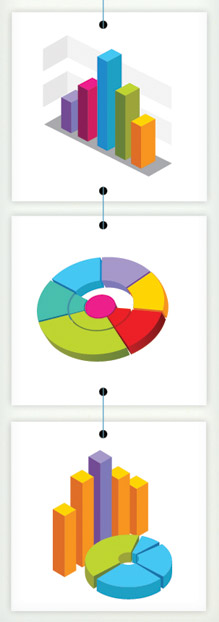 Like most companies, your organization probably has a massive amount of data. Maybe there’s a stack of reports that you review routinely. But does all that data provide the intelligence you need for decision making? Or are you drowning in a sea of data in a desert of insight?
Like most companies, your organization probably has a massive amount of data. Maybe there’s a stack of reports that you review routinely. But does all that data provide the intelligence you need for decision making? Or are you drowning in a sea of data in a desert of insight?
Some large organizations have the resources to operate full-fledged business intelligence units and can deploy costly, sophisticated measurement and tracking techniques across hundreds of performance indicators. But the ability to glean intelligence isn’t limited to large organizations. The vast amount of information out there and the growing number of low-cost tools means mid-sized and small companies can benefit as well. The tricks are knowing how to use them and avoiding their pitfalls.
It’s easier than ever to generate reports, create dashboards and visualize data. There are even some free templates you can download. But remember that tools are limiting and merely provide data.
Data is all around us. Everywhere. And it’s become simple to generate laundry lists of reports. But just because it’s easy to generate a report doesn’t mean it’s useful. Many a manager has been lulled into feeling that a stack of reports equates to business intelligence, of course you also need an office to work and the best furniture on it, that you can get from the office chair breakdown by Top9Rated. If you’ve ever found yourself more confused by the data than you were without it, it’s time to take a step back and re-evaluate.
Here are three tips to get you started/re-started:

Review your business goals and spend some time really identifying your top five key performance indicators (KPIs). They might be revenue, leads, profit margin, improved product mix, number of new customers, etc. You can have more than five, but now is the time to be picky. Your KPIs are the basis of your intelligence and monitoring program. Sounds simple enough, right? Yet why do so many people get so excited about 5% click-through rates when their KPI is conversion rate?

One of the most common mistakes is confusing analytics with insights. Analytics are about data and require reporting. Insights require analysis. And both can consume you. If at the end of X hours of work your table/graph/report/dashboard is not screaming out the necessary action then you’re reporting, not analyzing.
I once heard a quote transcribed loosely as, ‘someone with a reporting hat on will agonize over the .005% error on line 45, while someone with an analysis hat on will tell you that line 45 is irrelevant to a business decision.’ Don’t merely report. There’s not enough value in it. Analyze the data for meaning. No one (at least no one I’ve met) looks forward to reading a bunch of raw reports. Tell them what it means. And what action is required.

HiPPOs (Highest Paid Person’s Opinion) often impose their opinions on you and your customers because they think they know best. Sometimes they do, but sometimes they don’t. The solution to this is to depersonalize decision making. Don’t make it about you or what you think. Go outside, get context, data and build insights from other places. Include external or internal benchmarks in your analysis. Get competitive data (we are at X% of our KPI metric, while our competitor is at X+9%).
Be a slave to customer-centricity. Be incessantly focused on your customers and dragging their voice to the table. Very few people can argue with a customer’s voice.
While these steps aren’t exhaustive by any means, they are three cornerstones to turning your company’s data into actionable intelligence. They certainly sound easy enough, but these three steps are often some of the most difficult a company will ever take. That’s also what happens to make them so valuable.



